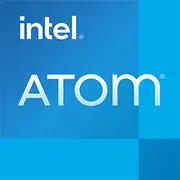Intel Atom x7-Z8750

Intel Atom x7-Z8750: Compact Energy Efficiency for Basic Tasks
April 2025
Introduction
The Intel Atom x7-Z8750 processor, released back in 2016, remains a niche solution for ultra-budget and specialized devices. Despite its almost decade-long age, it can still be found in new laptops priced under $300, focusing on minimalism and battery life. In 2025, it falls short compared to modern chips in every aspect except for price and power consumption, yet it continues to attract its own audience. Let’s explore who needs it and why.
Architecture and Process Technology
Cores, Threads, and Frequencies
- Airmont (Cherry Trail) Cores: 4 cores, 4 threads without Hyper-Threading support.
- Frequencies: Base clock — 1.6 GHz, turbo mode up to 2.56 GHz (but only for one core). The maximum for all cores is 2.4 GHz.
- Cache: L3 — 2 MB.
Integrated Graphics
- Intel HD Graphics 405: 16 EU (Execution Units) based on Gen8 architecture. Supports 4K via HDMI 1.4, but only at 30 Hz.
- Technologies: Quick Sync Video for H.265/HEVC decoding (but not encoding), DirectX 12.
Process Technology
14nm FinFET technology. For 2025, this is considered outdated (modern chips use 3–5 nm), but it helps reduce device costs.
Power Consumption and TDP
- TDP 2W: One of the lowest values in the history of x86 processors. Allows for passive cooling — no fans required.
- Power-saving Modes: Intel SpeedStep (dynamic frequency scaling), C-states (turning off unused blocks).
- Real-world Practice: In practical scenarios, consumption can reach 4–6W under peak load, but stays within 1–3W for office tasks.
Performance in Real Tasks
Office Work
- Examples: Google Docs, Microsoft Office, a browser with 5–7 tabs.
- Results: Adequate performance, but with delays when running multiple applications simultaneously. For instance, having Zoom open alongside the browser causes stuttering.
Multimedia
- Video: Smooth playback of 1080p/60fps (H.265) thanks to the decoder. 4K/30fps only via HDMI.
- Audio/Photo: Editing in Audacity or GIMP is possible, but with limitations.
Gaming
- Light Games: Among Us, Stardew Valley — 30–40 fps at low settings.
- Cloud Gaming: Xbox Cloud Gaming or GeForce NOW — the only way to play AAA titles.
Turbo Mode
- Features: Activates for 10–15 seconds during sudden load spikes (e.g., opening a browser). In multi-threaded tasks (PDF rendering), the frequency remains at 2.4 GHz until overheating occurs (after 2–3 minutes).
Usage Scenarios
Target Audience
- Students: For note-taking, reading PDFs, and online courses.
- Travelers: Devices with a battery life of 10–12 hours (e.g., Chuwi HiBook Pro 2025).
- Secondary Devices: A compact laptop for traveling in addition to a main PC.
Not Suitable For
- Video Editing/3D Modeling: Lacks sufficient power.
- Modern Operating Systems: Windows 11 runs slowly; optimal choices are Linux Lite or Chrome OS Flex.
Battery Life
- Working Time: 8–12 hours at 50% brightness (depending on the battery: devices with Atom x7-Z8750 typically have 30–40 Wh batteries).
- Technologies:
- Panel Self Refresh: Reduces screen power consumption.
- Connected Standby: Always-on mode without complete shutdown.
Comparison with Competitors
AMD
- A6-9220C (2019, 28nm): About 15% faster in multi-threaded tasks but has a TDP of 6W. By 2025, it is no longer found in new devices.
Intel
- Celeron N5100 (2021, 10nm): 2–3 times more powerful, TDP 6W. Laptops based on this chip start at $350.
Apple
- Apple M1 (2020): Not competitive on price but demonstrates how outdated the Atom x7-Z8750 is.
Pros and Cons
Strengths
- Price: Devices from $150 (e.g., Trekstor Primebook C11).
- Silence: No fan required.
- Compactness: Laptops are up to 15 mm thick.
Weaknesses
- Outdated Architecture: Does not support AVX2, lacks AI acceleration.
- RAM: Limited to 8 GB LPDDR3.
- Connection Options: No USB-C with Thunderbolt support.
Laptop Selection Recommendations
Types of Devices
- Transformer Ultrabooks: For example, Onda V820 (2-in-1 with touch screen).
- Tablets with Docking Stations: Suitable for reading and lectures.
What to Check Before Purchase
1. Screen: IPS matrix with at least 1080p (some models come with poor TN displays).
2. Storage: Must have an SSD (eMMC memory in budget models severely limits speed).
3. RAM: 8 GB is the minimum for Windows 11.
Final Conclusion
The Intel Atom x7-Z8750 in 2025 is suitable for those who:
- Are looking for the cheapest new device possible.
- Value battery life more than speed.
- Need a compact secondary device.
Key Benefits:
- Price under $300.
- All-day operation without recharging.
- Linux compatibility for enthusiasts.
Alternative: If your budget allows for $400–500, consider the Intel N100 or AMD Ryzen 3 7320U — they offer modern technologies without major compromises.
P.S. The Atom x7-Z8750 is a "digital bicycle": slow, but will get you there if you're not in a hurry.
Basic
CPU Specifications
Memory Specifications
GPU Specifications
Miscellaneous
Benchmarks
Compared to Other CPU
Share in social media
Or Link To Us
<a href="https://cputronic.com/en/cpu/intel-atom-x7-z8750" target="_blank">Intel Atom x7-Z8750</a>